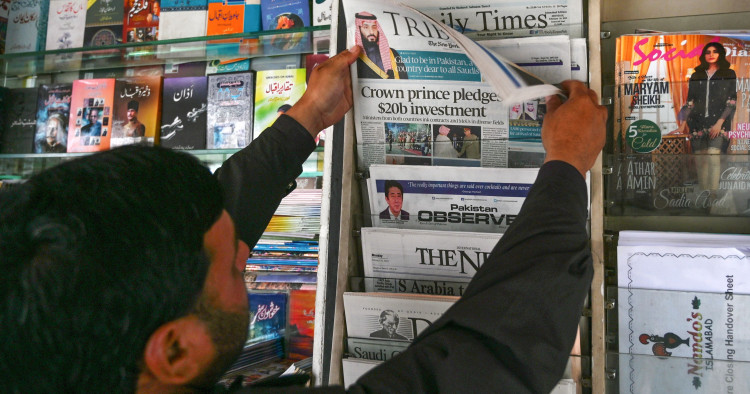The recent announcement of a China-brokered peace deal between Saudi Arabia and Iran initially took the world by surprise. The debate persists concerning whether this deal will last, its potential implications for the United States, what it means for the Middle East region (including Israel), and what brokering this agreement indicates about China’s rising power. However, the implications of the apparent rapprochement between Saudi Arabia and Iran extend even further, with significant consequences for vital neighboring regions like South Asia and other populous Muslim countries, including, notably, Pakistan.
Pakistan has for decades been an arena in the proxy war between Riyadh and Tehran that was sparked soon after the Iranian Revolution in 1979. Saudi Arabia provided financial and ideological backing to many Sunni militant groups trained in Pakistan that the U.S. Central Intelligence Agency (CIA) was arming to wage a jihad against the Soviets in Afghanistan. But some of these groups, such as Sipah-e-Sahaba, and its offshoot, Lashkar-e-Jhangvi, later turned their guns on the sizeable Shi’a minority in Pakistan. Iran responded by offering support to Pakistani Shi’a militants to counter this Sunni militancy. Iran also began to cooperate with India in Afghanistan after the Soviets withdrew in 1989 and U.S. attention shifted away from the region. New Delhi and Tehran notably both supported the Northern Alliance — comprised of a mixture of ethnic minorities, including the Shi’a — in the latter’s resistance to the predominantly Sunni Pashtun Taliban, which enjoyed good relations with Riyadh and Islamabad.
The post-9/11 U.S.-led intervention in Afghanistan caused a seismic shift in regional alliances. Motivated, in part, by its longstanding rivalry with the United States, Iran began cultivating ties with the Taliban as they waged war against the U.S. and North Atlantic Treaty Organization (NATO). Pakistan’s relations with Iran also improved during this time. Despite some friction along their shared border, Iran and Pakistan broached the possibility of regional energy cooperation, which ultimately led to the two countries signing a bilateral natural gas pipeline deal in 2013. Nonetheless, Pakistan continued dragging its feet on completing its portion of the pipeline, fearing both Saudi and American displeasure over cooperation with its heavily sanctioned western neighbor.
Pakistan’s relations with the U.S., meanwhile, have been tenuous at best, soured by their divergent strategic objectives in Afghanistan and America’s increasing reliance on India to counteract Chinese influence across South and Southeast Asia. Pakistan, on the other hand, has doubled down on its military and diplomatic ties with China, and the two have significantly boosted their economic ties by launching the $62 billion China-Pakistan Economic Corridor (CPEC) in 2015, dubbed a flagship project of China’s ambitious Belt and Road Initiative (BRI). China has included many Middle Eastern countries in the BRI, and it inked a 25-year strategic trade and investment accord with Iran in 2021, estimated to be worth between $200 billion and $300 billion. China’s move to involve Iran in the BRI may partly have been prompted by its desire to undermine India’s investment in the Iranian Chabahar deep-sea port on the Indian Ocean, viewed as a rival to the Chinese-controlled Pakistani deep-sea port in Gwadar.
For its part, Iran is trying to balance its relations with India and China. India recently used the Chabahar seaport to send shipments to Afghanistan, bypassing the need to cross Pakistani territory. Despite facing constraints due to the international sanctions regime, India had secured U.S. waivers to buy Iranian oil and to invest in Chabahar. Whether India will be able to maintain those relations with the Islamic Republic as its ties with the U.S. continue to grow remains to be seen. But the increasing acrimony between China and India certainly makes it unlikely that Chabahar and Gwadar can become “sister ports” to help enhance broader regional trade and connectivity.
Beijing’s attempt to simultaneously loop Iran and many of its arch-rival Arab states into the BRI may have been a key factor that informed its decision to step in to mediate one of the thorniest rivalries between Muslim nations in the Middle East. Other Muslim countries in the Gulf region and beyond, such as the United Arab Emirates, Turkey, and Pakistan, have applauded this high-profile Chinese diplomatic maneuver. For Pakistan, in particular, the tempering of the protracted Saudi-Iran rivalry could not only help lessen long-running domestic sectarian frictions but also alleviate pressure on Pakistani decisionmakers to involve Islamabad in contentious proxy tussles elsewhere in the Muslim world, as happened in Yemen. That said, even if the still fragile Saudi-Iranian rapprochement holds, Pakistan’s ability to improve its ties with the Islamic Republic will still be kept in check by concerns over further antagonizing the U.S.
Biden administration officials have cautiously welcomed Chinese efforts to try to de-escalate tensions in the troubled region while expressing reservations about Iran’s likelihood to stick to the deal. Yet for many Muslim-majority countries, including Pakistan, Beijing’s diplomatic endeavors are more immediately relevant and beneficial than those undertaken by Washington to bring the Gulf states and Israel together to deter Iran.
Dr. Syed Mohammad Ali is a Non-Resident Scholar with MEI’s Afghanistan and Pakistan Program, and he teaches courses on South Asia and human security in the Advanced Academic Programs at Johns Hopkins University.
Photo credit AAMIR QURESHI/AFP via Getty Images
The Middle East Institute (MEI) is an independent, non-partisan, non-for-profit, educational organization. It does not engage in advocacy and its scholars’ opinions are their own. MEI welcomes financial donations, but retains sole editorial control over its work and its publications reflect only the authors’ views. For a listing of MEI donors, please click here.













